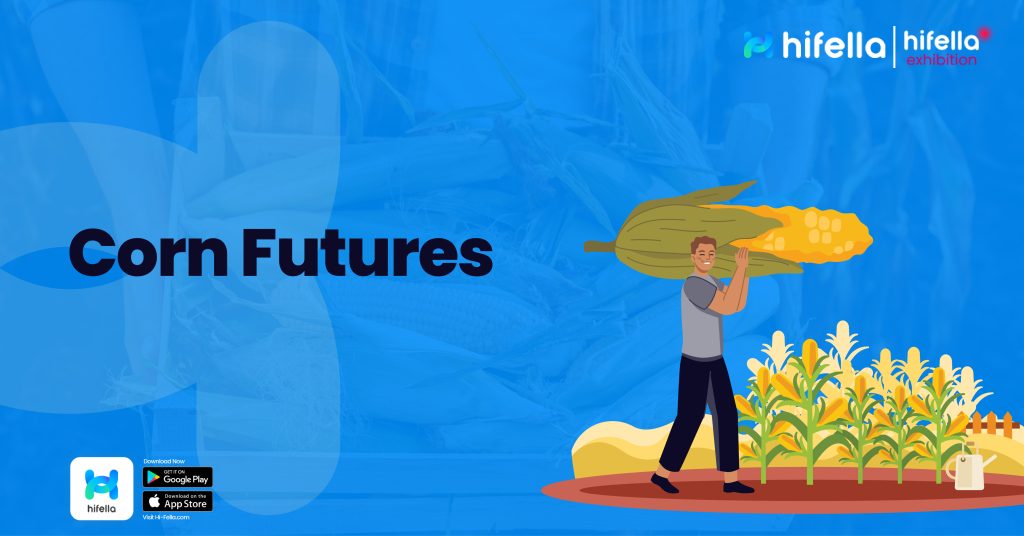Corn futures are a crucial part of the agricultural commodity market, providing traders and investors with opportunities to hedge against price fluctuations or speculate for profit.
Whether you’re an experienced trader or a beginner looking to diversify your portfolio, understanding corn futures is crucial for making informed decisions in this volatile market.
Definition and History of Corn Futures

Source: CNBC
Corn futures are agreements made on trading platforms where buyers commit to purchasing a certain amount of corn at a set price on a future date.
The story of corn futures began in the mid-1800s when the Chicago Board of Trade (CBOT) launched the first contracts for agricultural products.
These contracts helped farmers and buyers by allowing them to fix prices in advance, reducing the risk of sudden changes in corn prices.
Current Situation of The Corn Futures Market
According to Barchart on Monday, August 26, at 7:32 AM CDT, corn prices have dropped by 5 to 6 cents in early trading. This decline follows a decrease before the weekend, where most futures contracts fell by 2 to 4 cents, although some later contracts saw slight gains.
After a week-long Crop Tour, Pro Farmer reported an estimated U.S. corn yield of 181.1 bushels per acre and a production of 14.979 billion bushels, which is lower than the USDA’s estimates of 183.1 bushels per acre and 15.147 billion bushels.
Data from the Commitment of Traders showed that spec funds increased their net short position by 8,889 contracts, while commercials added 5,036 contracts to their net long position.
As of Monday morning, corn prices for different contracts were:
- September 2024: $3.67 3/4, down 3 3/4 cents
- December 2024: $3.91, down 2 1/2 cents
- March 2025: $4.09 1/2, down 2 cents
Cash prices also declined:
- Nearby Cash: $3.56 5/8, down 3 3/4 cents
- New Crop Cash: $3.47 3/8, down 4 1/4 cents
How Do Corn Futures Work?
Corn futures are contracts that let people buy or sell a set amount of corn, usually 5,000 bushels, at a future date.
These contracts are traded on special markets called futures exchanges, where prices go up and down depending on how much corn is available and how many people want to buy it.
Traders have two options:
- If they think the price of corn will go up, they can buy (this is called taking a “long position”).
- If they think the price will go down, they can sell (this is called taking a “short position”).
When the contract ends, traders can either exchange the actual corn or settle the deal with cash instead.
Factors Influencing Corn Prices

Source: Kompas.id
Corn prices can change for many reasons, making the market lively and sometimes hard to predict. Here are some key factors that influence corn prices:
- Weather Conditions
Extreme weather like droughts, floods, or unexpected cold snaps can greatly affect how much corn is harvested. If bad weather reduces the corn supply, prices can jump.
- Global Demand
As more countries, especially in emerging markets, need corn for food and other products, the demand increases. Higher demand often leads to higher prices.
- Government Policies
Decisions made by governments, such as subsidies to farmers, tariffs on imported goods, or international trade agreements, can influence corn prices both within a country and around the world.
- Energy Prices
Corn is a key ingredient in producing ethanol, a type of biofuel. When energy prices rise, the demand for ethanol and therefore corn can increase, pushing up corn prices.
- Technological Advances
New technology in farming, like better seeds or more efficient harvesting methods, can increase the amount of corn produced. This larger supply can help lower prices.
Benefits and Risks in Corn Futures Trading
Corn futures trading offers opportunities for profit but comes with risks. On one side, it allows traders to hedge against price changes and capitalize on market trends.
On the other side, it involves potential losses and requires careful strategy. Knowing both the benefits and risks is essential for anyone interested in this market. Here’s the list of benefits and risks:
Benefits
- Hedging Against Price Fluctuations: Farmers and companies involved in corn production or consumption can hedge against price changes, stabilizing their income or costs.
- Leverage: Futures trading allows for significant leverage, meaning traders can control large positions with relatively small capital.
- Liquidity: The corn futures market is highly liquid, allowing for easy entry and exit from positions.
Risks
- Market Volatility: Corn prices can be highly volatile, leading to substantial losses if the market moves against your position.
- Leverage Risks: While leverage can amplify gains, it can also magnify losses, leading to potential margin calls.
- Complexity: Futures trading requires a solid understanding of the market, and beginners may find it challenging to navigate without proper knowledge.
Trading Strategies for Corn Futures for Beginners
For those new to corn futures trading, it’s essential to start with a well-thought-out strategy:
- Trend Following
This strategy involves analyzing market trends and taking positions in the direction of the trend. If corn prices are rising, you would take a long position, and if falling, a short position. - Spread Trading
This strategy involves buying and selling two related futures contracts simultaneously to capitalize on the price difference between them. - Seasonal Trading
Corn prices often follow seasonal patterns, rising during planting season and falling post-harvest. Traders can use this information to time their trades. - Paper Trading
Beginners should start with paper trading (simulated trading) to practice strategies without risking real money.
Fundamental Analysis in Corn Futures
Fundamental analysis involves evaluating economic indicators, supply and demand factors, and other relevant data to predict future price movements. Key aspects include:
- USDA Reports: The U.S. Department of Agriculture regularly publishes reports on crop conditions, planting progress, and yield forecasts, which can significantly impact corn futures prices.
- Export Data: Monitoring export data helps traders understand global demand, which can influence prices.
- Inventory Levels: Tracking corn inventory levels can provide insights into supply-side pressures.
- Economic Indicators: Factors like GDP growth, currency exchange rates, and inflation can also affect corn futures prices.
Get Started with Corn Futures
Corn futures trading can be an exciting and profitable option for those interested in agriculture. But to succeed, it’s important to understand how the market works, what affects corn prices, and the risks involved.
By using smart trading strategies and keeping up with market news, you can make better decisions and take advantage of price changes.
Ready to start trading corn futures? Connect with suppliers and buyers at Hi-Fella! Trade with confidence today!








